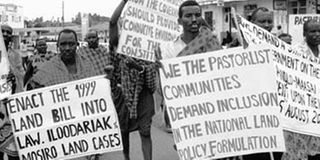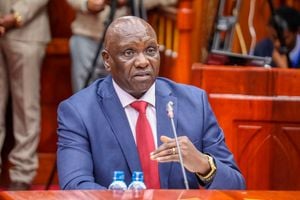How Masaais signed away Laikipia

Protesting at Kitengela in Kajiado District and below, a prison warder arranges swords and clubs confiscated after a demonstration.
Were it not for one unrestrained moment by the colonialists in 1911, the Maasai would not be involved in demands for their Laikipia land today.
In April that year, Governor Edouard Girouard collected some Maasai clan leaders, led by Paramount Chief Mark Ol-onana, to sign away the Laikipia land to European settlers.
Under the pact, the Maasai, who were settled in Laikipia, agreed to move to the Southern Reserve which spread from Suswa to Ngong along River Mbagathi.
The move to enter another treaty with the Maasais was driven by European settlers' urge to own "the sweet grazing grounds" of Laikipia.
Sadly, they had forgotten that an agreement signed seven years earlier barred any settler – white or black – from settling in Laikipia.
A clause in the August 10, 1904, treaty between East Africa's Protectorate Commissioner, Sir Donald Stewart, and 21 Maasai chiefs led by Laibon Lenana gave the Maasai Laikipia for eternity.
It stated: "We would, however, ask that the settlement now arrived at shall be enduring as long as the Maasai shall exist, and that European or other settlers shall not be allowed to take up land in settlements."
According to that agreement, the Maasai in the Rift Valley – northern Maasai – were moved to Laikipia while their southern counterparts were to stay south of a line drawn from Suswa to Ngong.
An area of 1,295 hectares on the Kinangop hills and Mau escarpment near Naivasha was set aside for the community's circumcision ceremonies held after every eight years.
To show their magnanimity, the colonialists signed away 1.3 million hectares in the Laikipia Plateau and another 1.16 million along the Suswa Ngong line to link the two new settlements for the Maasai.
Two extensions of the Laikipia reserve were promised by the colonialists but only one was given.
But the Laikipia reserve became an attraction spot for the European settlers who claimed they gave up 130,000 acres of land for extensions to the Suswa-Ngong reserve.
Sir Edouard maintained that they must be compensated by annexing the Laikipia land.
But the problem was the 1904 treaty which barred them from settling in the area.
For settlers to access the land, it had to be abrogated by a formal pact more superior, if not of equal standing.
A chance, however, presented itself late in 1909, when the Maasai were preparing to temporarily move from Laikipia to Kinangop for circumcision ceremonies.
The colonialists saw a chance of uniting them in one area, dumping the 1904 agreement and freeing Laikipia for European settlement.
Sir Girouard "lied" to the new Colonial Secretary, Lord Crewe, that leaders of the Maasai in Laikipia were willing to unite with their southern kinsmen.
At the same time, Laibon Lenana, who was living in Ngong, had begun to realise that splitting the Maasai into two separate enclaves was reducing his authority in Laikipia.
He, therefore, supported the move to reunite the Maasai in the Southern Reserve.
Governor Girouard then collected a group of Maasai "representatives" from the two reserves in Nairobi and the 1911 agreement was signed.
The Maasai and their flock were speedily forced out of Laikipia to the south because 195,399 acres of land had been earmarked for 27 settlers who included Lord Delamere and Hon R.B. Cole.
Confronted by his bosses about the move to settle Europeans in Laikipia, Sir Girouard resigned.
This is the agreement that Maasai leaders argue was signed under duress.
A bid by eight Maasai leaders led by Ole Njogo in 1912 to annul the 1911 treaty was quashed by a Mombasa magistrate, R.W. Hamilton.
Public Service minister William ole Ntimama has maintained the land was annexed at the barrel of a gun by the colonialists. "It was signed away under duress," he states.
Lands minister Amos Kimunya, basing his statement on the strength of the 1911 agreement, has stated the pacts guaranteed colonialists occupation of land for 999 years.
In the light of the status, he declared the invasion of the Laikipia land by Maasai youths "illegal and baseless" and warned those inciting the youths they would be punished.
Given that Laikipia was a settlement, its ownership was transferred to the government upon attainment of independence.
And because it was signed away to settlers in 1911, it is the very treaty that obtains in as far as the lease period of the land is concerned.
Most leases entered before independence carry a 999 year leasehold tag.
This is why Mr Kimunya warns: "The Government will act swiftly and firmly to ensure that private property is protected by all means."
The Draft Constitution, however, limits occupation of land by foreigners to 99 years.
However, Mr Ntimama has described Mr Kimunya's assertion as a fallacy that was not humanly possible.
"It's one of those things that only exist in the world of fantasies. It's not ... humanly possible to have a 1,000-year lease," he says.
The self-proclaimed defender of Maasai rights accuses his Cabinet colleague of being ignorant of the history of the land in question.
"People have not read history yet they go out to make statements about sensitive issues," he said.
Even the nine-man Maasai delegation which went to the Lancaster Conference in 1962 to negotiate the return of the community's land, he said, refused to sign away the property.
The delegation, led by Mr John Keen, included Philip Lemein, Jason ole Sein, Dr Likimani, Mr Justus ole Tipis and Mr J.L. Konchellah.
"They refused to sign until a provision to reclaim their land was included. Even today, no pact has been signed," says politician Haroun Lempaka.
Messrs Ntimama, Lempaka and Keen insist the treaties are not binding and the Government must move to address the problem.
From a human rights point of view, the Government is bound to settle the Maasai.
Yet the same government is constrained by the lease period that is borne out of the 1911 agreement signed by leaders who Mr Ntimama describes as soothe sayers.




